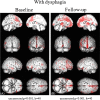Hypometabolism in the supplementary and anterior cingulate cortices is related to dysphagia in Parkinson's disease: a cross-sectional and 3-year longitudinal cohort study
- PMID: 23457325
- PMCID: PMC3612769
- DOI: 10.1136/bmjopen-2012-002249
Hypometabolism in the supplementary and anterior cingulate cortices is related to dysphagia in Parkinson's disease: a cross-sectional and 3-year longitudinal cohort study
Abstract
Objective: Dysphagia is one of the cardinal symptoms of Parkinson's disease (PD). It is closely related to the quality of life and longevity of PD patients. The aim of the study is to clarify the pathophysiological mechanisms responsible for dysphagia in PD.
Design: A cross-sectional and longitudinal comparative study.
Setting: Tohoku University Hospital.
Participants: Eight patients with dysphagia, 15 patients without dysphagia and 10 normal control subjects.
Main outcome measures: The time needed for swallowing initiation and changes in brain glucose metabolism at baseline and after a 3-year follow-up period.
Results: The time needed for swallowing initiation was significantly longer in the patients with dysphagia compared with the patients without dysphagia at baseline and after the 3-year follow-up period (p<0.05). The patients with dysphagia exhibited hypometabolism in the supplementary motor area (SMA) and the anterior cingulate cortex (ACC) compared with the 10 normal control subjects at baseline (uncorrected p<0.001). After the 3-year follow-up period, the number of brain areas showing hypometabolism increased, involving not only the SMA and the ACC but also the bilateral medial frontal lobes, middle cingulate cortex, thalamus and right superior, middle, inferior and orbital frontal gyri (uncorrected p<0.001). In contrast, the patients without dysphagia showed virtually no regional hypometabolism at baseline (uncorrected p<0.001) and only a small degree of hypometabolism in the SMA and ACC after the 3-year follow-up period (uncorrected p<0.001).
Conclusions: These results suggest that dysphagia in PD patients is mainly related to a difficulty in swallowing initiation that is based on a combination of poor movement planning due to SMA dysfunction and impaired cognitive processing due to ACC dysfunction.
Figures




References
-
- Nakashima K, Maeda M, Tabata M, et al. Prognosis of Parkinson's disease in Japan. Tottori University Parkinson's Disease Epidemiology (TUPDE) Study Group. Eur Neurol 1997;38(Suppl 2):60–3 - PubMed
-
- Fall PA, Saleh A, Fredrickson M, et al. Survival time, mortality, and cause of death in elderly patients with Parkinson's disease: a 9-year follow-up. Mov Disord 2003;18:1312–16 - PubMed
-
- Bushmann M, Dobmeyer SM, Leeker L, et al. Swallowing abnormalities and their response to treatment in Parkinson's disease. Neurology 1989;39:1309–14 - PubMed
-
- Bird MR, Woodward MC, Gibson EM, et al. Asymptomatic swallowing disorders in elderly patients with Parkinson's disease: a description of findings on clinical examination and videofluoroscopy in 16 patients. Age Ageing 1994;23:251–4 - PubMed
LinkOut - more resources
Full Text Sources
Other Literature Sources
